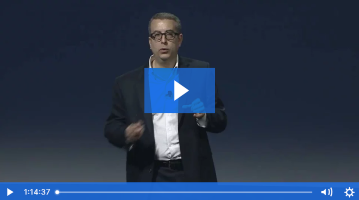How Bunge Overcame the Global Challenge of Centralizing HR Processes
Inside the Agribusiness and Food Company’s Platform for Bringing a Global Organization’s Talent Together with SAP SuccessFactors Solutions
by Tom LeBlanc, Contributing Writer
Any company that’s been around for a few years and has more than one office likely has some non-uniform business processes and applications. Today’s forward-focused companies that understand the value of gathering and acting upon business metrics, however, embrace uniformity when it comes to processes and creating a consistent platform for data collection.
Consider that agribusiness and food company Bunge has been around for over 200 years. This business started in Europe but now has bustling offices across the globe. Over the course of two centuries and 30 global locations, you can bet Bunge acquired some deeply embedded and sometimes disparate business processes, particularly in the area of human resources (HR).
Yann Ribager, HR IT Director for Bunge, can attest to this. When he came on board in 2012, he recognized that, across the company, there were several different systems used to manage time, benefits, and payments. “The first mission was to perform an exhaustive audit of all the systems,” he says, referring to an immersive task during his first six months with Bunge.
The result saw Bunge embracing SAP SuccessFactors solutions, but not before yet another exhaustive process of assessing needs and evaluating vendors. In this article, Ribager offers a window into the process of consolidating Bunge’s talent applications and the results the company has seen to date.
Understanding the Task at Hand
Bunge is indeed one of those forward-focused companies that values uniformity. Having consistent business processes for talent management was a priority for Bunge even before Ribager came on board and was tasked with auditing HR systems. “They wanted business leaders to have harmonized processes across all regions in evaluating people’s performances as well as planning successions and rolling out training,” he recalls. “But we really didn’t have that in 2012. We had some global processes, but the regions were adapting them to their needs or with their own tools — and ultimately having different interpretations.”
The company recognized that it had to do something globally for HR functions to work better together and support the business.
Rolling Out a Global Platform in the Cloud
Bunge realized early on that any talent management solution it chose would be cloud based versus on premise. “We only considered cloud vendors,” Ribager says. “We knew that if we wanted something implemented rather quickly and to offer global support, a cloud solution would be the best approach.” In Europe, where he is based, the region was already using a cloud solution for talent management that the team had been developing. Bunge ultimately selected SAP SuccessFactors solutions and, in hindsight, “it was the best choice we could have made,” he says.
One of the big focuses for Bunge as it rolled out SAP SuccessFactors solutions was performance. Since the company’s compensation model was closely tied to performance, it chose to implement SAP SuccessFactors Compensation and SAP SuccessFactors Performance & Goals in tandem. The natural next step was SAP SuccessFactors Succession & Development, followed by SAP SuccessFactors Learning for its learning management system.
Following this process validated Bunge’s priority to have a centralized core HR solution where all the different systems in Europe and Asia for managing employee data would transition to. “Being an SAP on-premise customer in Europe and in Asia, we went through the analysis of SAP core functionality for HR and payroll and were able to build something there,” he says.
Soon, Bunge was made aware of SAP’s cloud-based human resource information system (HRIS) — SAP SuccessFactors Employee Central. “We implemented SAP SuccessFactors Employee Central a couple of months after compensation went live,” Ribager says, adding that flexibility and timeline is significant, because it shows that companies don’t necessarily have to start with SAP SuccessFactors Employee Central.
Thanks to great teamwork and collaboration, Bunge completed its SAP SuccessFactors Employee Central integration in Europe and Asia in 2015.
Enlisting Third-Party Assistance
The year 2016 was one of transition for Bunge. With Europe and Asia on the SAP SuccessFactors platform, Bunge was focused on a true global HR platform covering its large presence in North America (about 4,500 employees) and South America (about 18,000 employees). “It was a big project, and we understood we needed a consultancy to work with us on this,” Ribager says.
Around that time, Deborah Borg joined Bunge as Chief Human Resources and Communications Officer. The priority to become a more global-focused organization implied that all candidates and new employees had the same experience globally. “The mission was for us to create a global recruiting solution and find the best partner to bring in high expertise around these topics,” she says.
After a standard request-for-proposals (RFP) process, Bunge selected Infosys, in part because of the footprint this multinational corporation offered. “They’re present in key geographies where Bunge operates, especially in South America,” Ribager says. “Countries like Brazil and Argentina were very important for us, and Infosys was able to respond with local on-site support in Portuguese and Spanish languages — that was really key.”
Bunge worked closely with Infosys on organizational change management (OCM). The biggest challenges existed in terms of transforming technology from the on-premise system to SAP SuccessFactors solutions — and Infosys delivered skilled OCM leads in Brazil.
“Infosys proposed a useful methodology to empower the South American OCM leads,” says Ribager. “They developed a strong program with surveys and interviews with different levels of leaders to get their feedback on current technology and identify their expectations. They gave us guidance on where we needed to focus in terms of change management, training, and even processes. They stayed side by side with us at the beginning and were able to hand it off to us gradually as we were able to manage it internally.”
Meanwhile, Infosys provided Bunge with a tool that allows automatic data migration based on customized rules from the on-premise system to the cloud. The data is then transformed and injected back into the SAP SuccessFactors solutions automatically, Ribager says. “This allowed us to accelerate the migration of the data. This was a big-ticket item for us, because I know from experience that the migration of data can take a lot of time.”
Achieving Benefits Beyond HR
A massive initiative such as Bunge’s global consolidation of HR processes doesn’t come without difficulties. Some challenges stemmed from Bunge’s own ambitions. “One of the good aspects of SAP SuccessFactors solutions is that they are highly configurable, which at the same time, can end up being a challenge,” Ribager quips. “As much as you want to approach global in a consistent way, you have to adapt to regional needs and requirements.”
An example came in Brazil where Bunge went live with SAP SuccessFactors solutions in conjunction with a Brazilian governmental program that requires companies to transfer certain HR data to authorities, such as new hires and terminations. “This program required even more data than Bunge was maintaining at the time, and SAP SuccessFactors solutions allowed us to customize all that was needed,” Ribager says. “As a result, we had to make country-specific provisions — creating a challenge on the business side when it comes to striving for global processes and standardization.”
In many ways, overcoming the integration challenges and embracing a more global HR platform has paid big dividends for Bunge. Getting that global exposure has been significant for individual employees, according to Ribager. “Back in 2012, a manager sitting in Hungary had no idea how he or she was positioned globally. Now, thanks to this platform, any employee can browse the organization and realize how they interact with the rest of the company. In their profiles, they can indicate the next role they envision for themselves. All this is considered in the succession process and talent reviews. That’s really key for employees.”
Managers, meanwhile, may have direct reports all over the global organization. The new global platform makes it easier to manage people, keep track of their talent reviews, and document discussions.
The benefits of Bunge’s SAP SuccessFactors integration have the potential to extend beyond HR. The solution, which was named People@Bunge, is a clear example of the company’s focus on people and innovation. Thanks to the benefits of best-in-class cloud-based solutions, Bunge now has enhanced security and protection of employees’ data, as well as improved accessibility from anywhere, anytime. People@Bunge is the organization’s most far-reaching platform. “We’re even able to build non-HR processes into this platform,” says Ribager. “It’s the only software that we have today with this reach to our employee base, so it’s a major benefit for us.”








